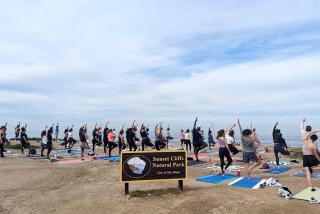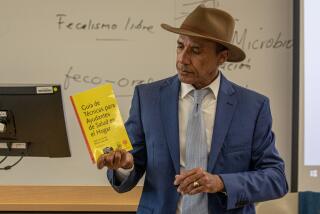Unspoken Skills
- Share via
Anne Jackson teaches American Sign Language at McCambridge Recreation Center in Burbank. Half of those taking the weekly course are school-age children, 8 years old and older; half are adults.
What motivates a hearing child to take a course in sign language?
“The kids show up because they have deaf friends,” Jackson said, adding that many attend schools that have mainstreamed deaf children. “Kids make friends easily and when they have deaf friends they want to communicate with them,” said Jackson, who herself is not hearing-impaired.
Jackson, a sign-language interpreter who regularly provides services for deaf and hearing-impaired students at Cal State Northridge, began teaching sign language at the Burbank Park and Recreation Department site last fall. “The response was so great in the first session that everybody wanted to continue on,” she said.
Enrollment is still open for the next session, which starts tonight. Depending on the number who enroll, students may be divided into two groups--one for beginners and one for those who already know the basics.
“I try to make it fun,” she said. “Each session I teach vocabulary and practice sentences for a while, and then we use the information I just taught.” She has put her class syllabus together from half a dozen sign-language reference books. “There are certain rules for finger spelling and other rules for signs (a whole word),” she said.
Kids don’t take notes as well as adults, she says, but they pick up signing much faster. “When I say, ‘OK, what’s the sign?’ (for a word), it’s a kid who remembers,” Jackson said.
One interesting result is that when the kids are paired with adults in practice sessions, both sides of the generation gap benefit from the encounter.
“The kids (function to) make the classwork easier for the adults to understand, and the kids see that adults struggle to remember the signs. The setting puts both on an equal basis,” she said.
Her goal, as she puts it to her students, is to “set things up in front of you, keeping your hands near your face. Sign language is a beautiful language (with) facial expressions and body language to provide context.”
Herself the mother of four children, Jackson is wise in the ways of teaching young ones. “Kids have fun signing. Adults are set in their ways and have to struggle,” she said.
Jackson learned to sign from a teacher on the East Coast. When she arrived at CSUN, she learned that she had the signing equivalent of an accent. “I discovered signing was different on the East Coast,” she said, “and you have to pay attention to those little differences to be understood.”
She will, of course, be teaching the regional version of American Sign Language at her sessions, having learned the regional “accent” in the course of her work with hearing-impaired students in the Valley.
It’s all a part of what she sees as her commitment to “teaching deaf children to live in a hearing world and (teaching) hearing children to learn to live with deaf children.”
BE THERE
American Sign Language instruction, ages 8 and older, Thursdays from 6-7 p.m., today-March 5, McCambridge Recreation Center, 1515 N. Glenoaks Blvd. Burbank. Fee $30 for Burbank residents, $35 for nonresidents, plus materials. (818) 238-5378.


